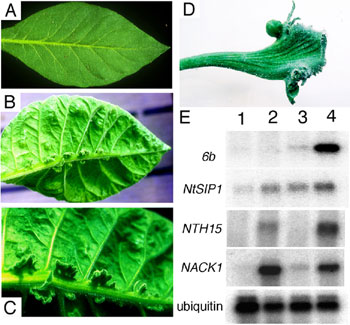| IV. MOLECULAR
FUNCTIONS OF ONCOGENE 6b
DERIVED FROM Agrobacterium Recent reference Kitakura et al., The Plant Cell (2002) The 6bgene in the T-DNA from Agrobacterium tumefacienshas
oncogenic activity in plant cells, inducing tumor formation, the phytohormone-independent
division of cells and altered leaf morphology. The product of the
6bgene
appears to promote some aspects of the proliferation of plant cells but
the molecular mechanism of its action remains unknown. We have recently
showed that the 6b protein associates with nuclear-localized protein NtSIP1
(Nicotiana tabacum 6b-interacting protein 1) of tobacco. NtSIP1
is supposed to be a transcription factor since its predicted amino acid
sequence includes two regions that resemble, respectively, a nuclear-localization
signal and a putative DNA-binding motif, which is similar in terms of amino
acid sequence to the tri-helix motif of rice transcription factor GT-2.
A fusion protein composed of the DNA-binding domain of yeast GAL4 protein
and 6b protein activated the transcription of a reporter gene under the
control of the chimeric promoter that contained the GAL4 upstream-activating
sequence and the CaMV 35S minimal promoter in tobacco cells. Furthermore,
nuclear localization of green fluorescent protein-fused 6b protein was
enhanced by NtSIP1. A cluster of acidic residues in 6b protein appeared
to be essential, for nuclear localization and for transactivation, as well
as for the hormone-independent growth of tobacco cells. We propose
that 6b protein might act in the proliferation of the plant cells, at least
in part, through an association with NtSIP1.
|
